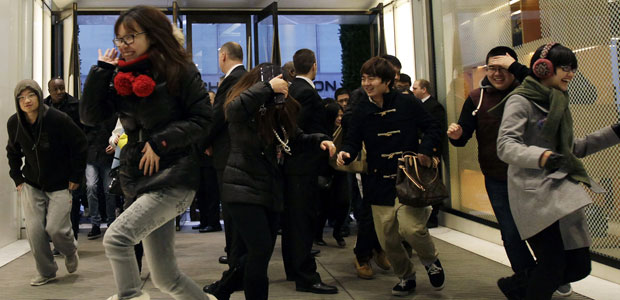Christmas shopping gives high street sales a lift
With retail sales rising in the run-up to Christmas, Channel 4 News looks at the high street victims of the economic downturn.

Sales increased by 0.6 per cent in December, compared with the previous month, according to figures from the Office for National Statistics (ONS). They were boosted by spending in clothing chains and department strores.
But with fears that Britain is back in recession, and shoppers cutting back on non-essential items, the retail sector is poised for a tough year.
‘Hunker down’
Howard Archer, chief UK and European economist at IHS Global Insight, said: “The risk remains that pressurised and worried consumers will put away their purses and wallets, and hunker down for an extended period after a late flurry of spending in the run-up to Christmas and then taking advantage of the best of the bargains in the clearance sales.”
The ONS said consumers spent £42.1bn in the retail sector in December, compared to £29bn in November and £39bn the previous year. Online sales accounted for 10.9 per cent of business, worth £837.1m.
Winners and losers
Department store chains John Lewis and House of Fraser fared well, as did Matalan, Next, Ted Baker, JJB Sports, Poundland and Majestic Wine.
Debenhams experienced flat trading conditions, while sales at Dixons and Game fell. Luxury brand Burberry performed well, while Mulberry saw an increase in sales of 30 per cent over a 16-week period.
It was inevitable December was going to be a strong month. Sarah Peters, Verdict Research
Sarah Peters, lead analyst at Verdict Research, told Channel 4 News that after weak trading in October and November, “when people didn’t go out and buy clothing”, because of the level of discounting in the run-up to Christmas, “it was inevitable December was going to be a strong month”.
While the “value end of the market” like Matalan, New Look and Primark had done well, Ms Peters said people also wanted “aspirational” goods from brands such as Burberry and Mulberry.
“People want something that is value for money. If they want to buy something special, then it’s not just about price. It’s about saying that if I’m going to spend money, I want that money to be spent on something that’s really worthwhile, something I’m going to get a lot of use out of. Department stores seem to have done very well because of their convenience, so people can shop for different products at the same place,” she said.
Read more from Channel 4 News: Q&A on what's next for the British high street

Economy, stupid
The 2008-09 recession coincided with a 5 per cent fall in output – in other words, the British economy was 5 per cent smaller when the recession ended than it was when it began.
Since then, Britain has returned to growth, albeit at a low rate. Many commentators believe it is now in the midst of another recession, but a shallow one.
Rising unemployment, falling household incomes and the rise in VAT have combined to put further pressure on the British high street as consumers tighten their belts.
Woolworths, known for its clothes, books, games and pick ‘n’ mix sweets, was the first major casualty of the recession. Its name still survives online, but its 800 stores throughout the UK had closed their doors by January 2009, with the loss of 27,000 jobs. It was a sad end to a staple of the high street that had been around for a century.
Thorntons, founded in 1911, plans to shut 180 stores over the next three years. Its chocolate will not disappear, but it will not have the presence it once did.
Jane Norman, the women’s clothing retailer, has been around since the 1950s. It went into administration in June 2011, with Edinburgh Woollen Mill buying 33 of its 94 stores.
Oddbins, once the favourite of the wine-buying middle classes, was founded in 1963 and had 278 stores at its peak. It too went into administration in 2011, but 37 of 128 stores were saved – another example of a high street staple that has drastically downsized.
Home furnishings retailer Habitat was founded by Terence Conran in 1964. By September 2011, 30 of its stores had closed, leaving just three in London.
Borders, the booksellers, went into administration in 2009, with all of its stores closing by the end of the year.
The shoe chain Barratts also had a tough 2009. Since then, 100 stores have closed and 2,500 employees have lost their jobs. But 89 Barratts and Priceless stores have survived, along with more than 1,000 jobs, and there are now plans to take the chain upmarket.
Lingerie retailer La Senza, founded in 1990, was saved from administration last week. Kuwait-based Alshaya bought 60 of 146 strores, safeguarding more than 1,000 jobs. Another 84 stores closed, with 1,300 job losses.
Blacks Leisure, the outdoor clothing and camping specialists, employs 3,500 people at 100 Blacks and 200 Millets branches. It also went into administration and has just been bought by JD Sports. The new owners have warned that “under-performing” stores” will close.
Analyst Sarah Peters sees a difficult 2012 for retailers, “but there will be more cause for optimism at the end of the year, with the Olympics and the Diamond Jubilee”.
Read more from Channel 4 News: the future of manufacturing
-
Latest news




